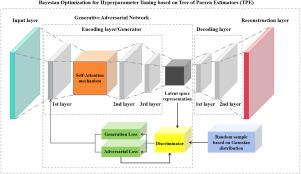A self-attention enhanced generative adversarial autoencoder for anomaly detection of self-discharge of lithium-ion batteries
IF 8
2区 计算机科学
Q1 AUTOMATION & CONTROL SYSTEMS
Engineering Applications of Artificial Intelligence
Pub Date : 2025-07-10
DOI:10.1016/j.engappai.2025.111495
引用次数: 0
Abstract
Self-discharge is a crucial parameter affecting the reliability and lifespan of lithium-ion batteries (LIBs). However, traditional methods for detecting self-discharge rely heavily on time-consuming experimental testing. To address this limitation, we propose a novel model, self-attention enhanced generative adversarial autoencoder (SAE-GAAE), for rapid and accurate LIB self-discharge anomaly detection. SAE-GAAE integrates recent advances in artificial intelligence into battery production scenarios by combining a dot-product self-attention mechanism within the encoder-which captures inter-feature dependencies and highlights key indicators-with a generative adversarial component in the latent space, which enhances generalization and robustness by regularizing feature representations. This end-to-end deep learning framework enables automatic extraction of informative representations from raw input data without relying on manual feature engineering. Moreover, a tree-structured Parzen estimator (TPE)-based Bayesian optimization algorithm is employed to efficiently fine-tune model hyperparameters, improving detection performance. Applied to the capacity grading stage in LIB production, the model uses 40 features – including voltage, current, capacity, and temperature – extracted from charge–discharge curves. Experimental evaluation on real-world production data demonstrates that SAE-GAAE achieves a 26. 27% improvement in the average area under the receiver operating characteristic curve (AUC-ROC) in four models based on the autoencoder, with a detection accuracy of 99.05% and a recall rate of 100%. These results highlight the model’s practical value in enhancing battery screening efficiency while reducing reliance on long-duration standing tests.

一种用于锂离子电池自放电异常检测的自关注增强生成对抗自编码器
自放电是影响锂离子电池可靠性和寿命的关键参数。然而,传统的自放电检测方法严重依赖耗时的实验测试。为了解决这一限制,我们提出了一种新的模型,自关注增强生成对抗自编码器(SAE-GAAE),用于快速准确地检测LIB自放电异常。SAE-GAAE通过将编码器内的点积自关注机制(捕获特征间依赖关系并突出关键指标)与潜在空间中的生成对抗组件相结合,将人工智能的最新进展集成到电池生产场景中,通过正则化特征表示来增强泛化和鲁棒性。这种端到端深度学习框架可以从原始输入数据中自动提取信息表示,而无需依赖手动特征工程。此外,采用基于树结构Parzen估计器(TPE)的贝叶斯优化算法对模型超参数进行有效微调,提高了检测性能。该模型应用于锂电池生产中的容量分级阶段,利用从充放电曲线中提取的电压、电流、容量和温度等40个特征。对实际生产数据的实验评估表明,SAE-GAAE达到了26。基于自编码器的4种模型的受试者工作特征曲线下平均面积(AUC-ROC)提高27%,检测准确率为99.05%,召回率为100%。这些结果突出了该模型在提高电池筛选效率,同时减少对长时间站立测试的依赖方面的实用价值。
本文章由计算机程序翻译,如有差异,请以英文原文为准。
求助全文
约1分钟内获得全文
求助全文
来源期刊

Engineering Applications of Artificial Intelligence
工程技术-工程:电子与电气
CiteScore
9.60
自引率
10.00%
发文量
505
审稿时长
68 days
期刊介绍:
Artificial Intelligence (AI) is pivotal in driving the fourth industrial revolution, witnessing remarkable advancements across various machine learning methodologies. AI techniques have become indispensable tools for practicing engineers, enabling them to tackle previously insurmountable challenges. Engineering Applications of Artificial Intelligence serves as a global platform for the swift dissemination of research elucidating the practical application of AI methods across all engineering disciplines. Submitted papers are expected to present novel aspects of AI utilized in real-world engineering applications, validated using publicly available datasets to ensure the replicability of research outcomes. Join us in exploring the transformative potential of AI in engineering.
 求助内容:
求助内容: 应助结果提醒方式:
应助结果提醒方式:


